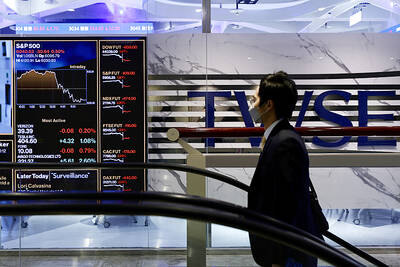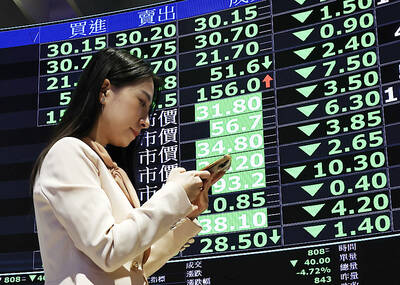Japanese consumer electronics giant Sony Corp aims to recoup its top position in Taiwan's rapidly-growing television market this year by launching more and bigger-sized liquid-crystal-display (LCD) TVs, a company official said yesterday.
The Japanese TV brand regained the leading position in the mainstream 32-inch size segment in Taiwan in December last year, with the help of its lower-priced "Bravia" sub-brand last year.
"The Bravia series is very successful. We have been trying to catch up with consumer demand since we launched the brand," said Hiroyuki Oda, president of Sony's consumer electronics division in Taiwan.
"We hope the growth momentum will carry into this year," Oda said. "We hope to take the number one position this year," he said.
Oda also said Sony aims for double-digit growth in sales for his division this year from last year.
However, he declined to give detailed numbers.
Sony lost its top position in the nation's LCD TV market to Matsushita Electric Industrial Co, which sell consumer electronics products under the Panasonic brand, in 2004 and 2003.
But the company was on target last quarter globally, nabbing around a 15 percent share of the market.
Sony overtook Sharp Corp to become the world's biggest LCD TV brand due to the successful launch of the Bravia series and optimized panel capacity through S-LCD Corp, its TFT-LCD joint venture with Samsung, according to a DisplaySearch report released yesterday
Sony's progress was also helped by strong demand for large-sized LCD TVs, fueled by an almost 50 percent drop in prices year-on-year, the market researcher said.
In the third quarter of last year, Sony was ranked No.4 with a market share of less than 9 percent, it added.
DisplaySearch expects sales of LCD TVs to more then double to 42 million units around the globe this year, from 19 million last year.
"We believe the growth will also be rapid in Taiwan," Oda said.
Oda said LCD TV sales are expected to reach as high as 500,000 units this year, from around 300,000 units last year, with LCD TV sales accounting for 50 percent of total TV sales.
"The trend is clear that LCD TVs are taking over from traditional CRT [cathode-ray-tube] TVs," Oda said.
He said more consumers will now consider buying the slim-screen TVs as prices are stabilizing after plunging in the second half of last year.
Based on the optimistic outlook, Sony plans to introduce more models with large-sized screens in the Taiwanese market, Oda said.
He declined to comment on whether Sony would increase its purchases of LCD panels from local manufacturers -- including AU Optronics Corp (友達光電) -- this year amid supply constraints at S-LCD.

SELL-OFF: Investors expect tariff-driven volatility as the local boarse reopens today, while analysts say government support and solid fundamentals would steady sentiment Local investors are bracing for a sharp market downturn today as the nation’s financial markets resume trading following a two-day closure for national holidays before the weekend, with sentiment rattled by US President Donald Trump’s sweeping tariff announcement. Trump’s unveiling of new “reciprocal tariffs” on Wednesday triggered a sell-off in global markets, with the FTSE Taiwan Index Futures — a benchmark for Taiwanese equities traded in Singapore — tumbling 9.2 percent over the past two sessions. Meanwhile, the American depositary receipts (ADRs) of Taiwan Semiconductor Manufacturing Co (TSMC, 台積電), the most heavily weighted stock on the TAIEX, plunged 13.8 percent in

A wave of stop-loss selling and panic selling hit Taiwan's stock market at its opening today, with the weighted index plunging 2,086 points — a drop of more than 9.7 percent — marking the largest intraday point and percentage loss on record. The index bottomed out at 19,212.02, while futures were locked limit-down, with more than 1,000 stocks hitting their daily drop limit. Three heavyweight stocks — Taiwan Semiconductor Manufacturing Co (TSMC, 台積電), Hon Hai Precision Industry Co (Foxconn, 鴻海精密) and MediaTek (聯發科) — hit their limit-down prices as soon as the market opened, falling to NT$848 (US$25.54), NT$138.5 and NT$1,295 respectively. TSMC's

TARIFFS: The global ‘panic atmosphere remains strong,’ and foreign investors have continued to sell their holdings since the start of the year, the Ministry of Finance said The government yesterday authorized the activation of its NT$500 billion (US$15.15 billion) National Stabilization Fund (NSF) to prop up the local stock market after two days of sharp falls in reaction to US President Donald Trump’s new import tariffs. The Ministry of Finance said in a statement after the market close that the steering committee of the fund had been given the go-ahead to intervene in the market to bolster Taiwanese shares in a time of crisis. The fund has been authorized to use its assets “to carry out market stabilization tasks as appropriate to maintain the stability of Taiwan’s

STEEP DECLINE: Yesterday’s drop was the third-steepest in its history, the steepest being Monday’s drop in the wake of the tariff announcement on Wednesday last week Taiwanese stocks continued their heavy sell-off yesterday, as concerns over US tariffs and unwinding of leveraged bets weighed on the market. The benchmark TAIEX plunged 1,068.19 points, or 5.79 percent, to 17,391.76, notching the biggest drop among Asian peers as it hit a 15-month low. The decline came even after the government on late Tuesday authorized the NT$500 billion (US$15.2 billion) National Stabilization Fund (國安基金) to step in to buoy the market amid investors’ worries over tariffs imposed by US President Donald Trump. Yesterday’s decline was the third-steepest in its history, trailing only the declines of 2,065.87 points on Monday and